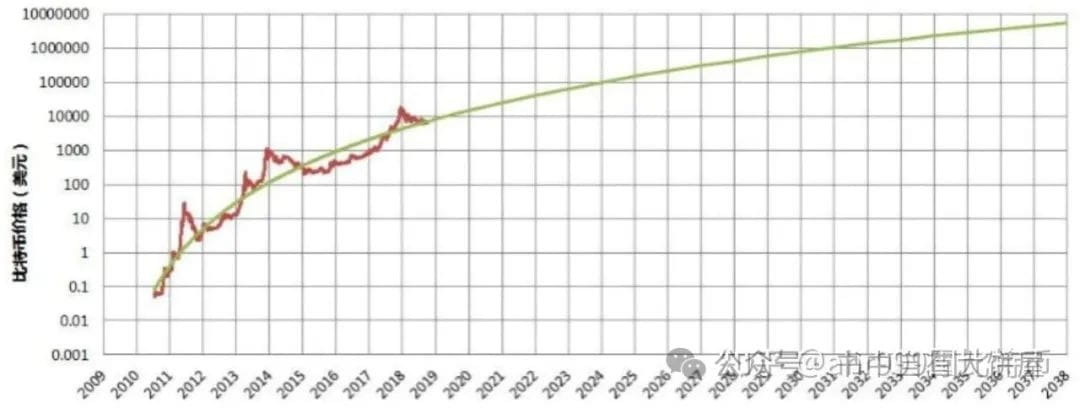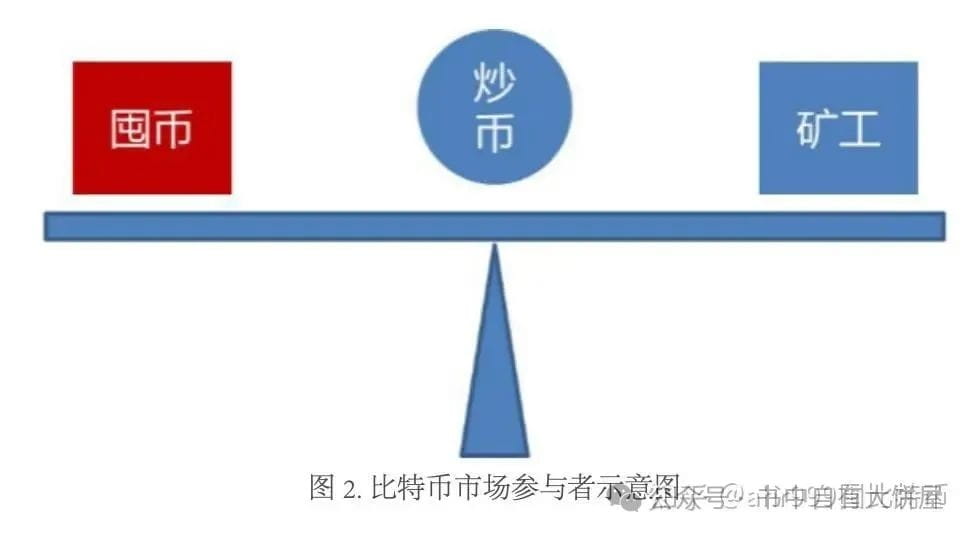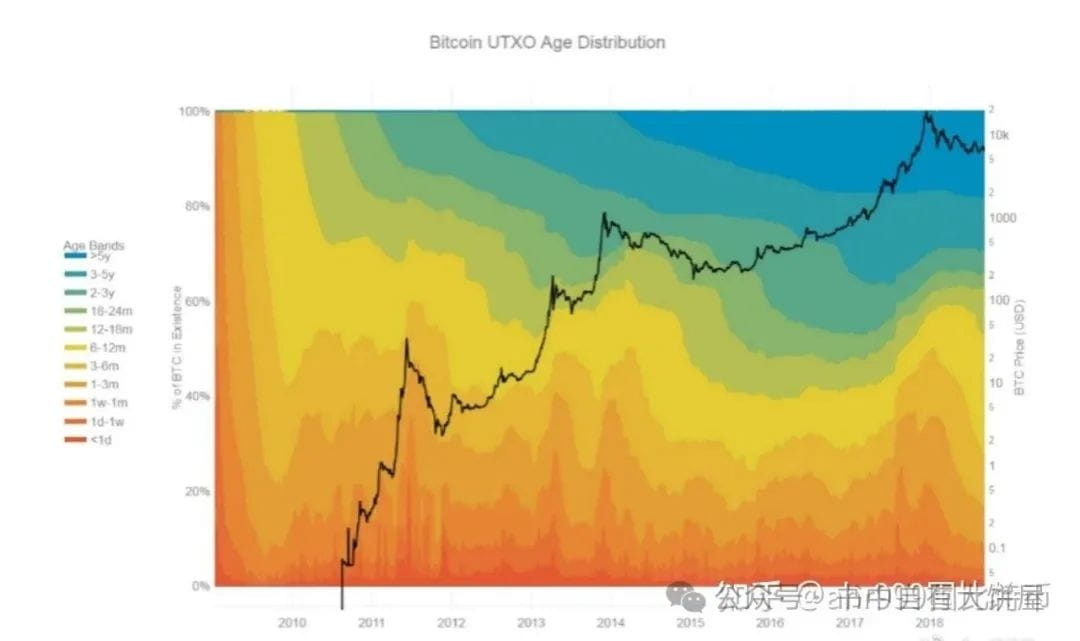What exactly determines the price of Bitcoin? Why does a halving lead to a skyrocketing price for Bitcoin?
Now, we have reached the entry standard for hoarding Bitcoin: clarifying the goals of Bitcoin, being willing to participate in the experiment, voluntarily bearing risks, and starting to use Bitcoin as a store of value, controlling Bitcoin private keys, and engaging in cold storage.
So, next, we don't need to do anything; we just need to wait.
However, waiting idly is indeed too boring, so let's continue to learn something. This article shares my personal understanding of the Bitcoin price model. It should be noted that I am not formally trained in economics, so you can consider me an amateur; critiques and corrections are welcome.
First, let's take a look at Bitcoin's past price trends (Figure 1).

Historical price fitting and future price predictions of Bitcoin (Figure 1)
This trend can be perfectly modeled with exponential growth, and based on the fitting results, it is predicted that the price of Bitcoin in 20 years should be around 7 million dollars, or approximately 50 million RMB. This is consistent with our previous prediction in (Getting Out Too Early Just Because the Vision is Too Small).
Considering the absolute advantage of Bitcoin as a store of value compared to gold, currency, and real estate, each Bitcoin will rise to 7.5 million dollars, equivalent to 50 million RMB.
So where exactly is the root of Bitcoin's price? The answer is: you. We can simply divide the Bitcoin market into three types of participants: hoarders, miners, and speculators.

Diagram of Bitcoin market participants (Figure 2)
Hoarders are buyers, and miners are sellers. Initially, there were only these two types of people. Because these two types of people have transaction demands, exchanges, and a third type of person emerged: speculators. Speculators are fickle; when the market is rising, they slide towards the hoarders' side, and when the market is falling, they slide towards the miners' side.
Of course, one person may simultaneously be a hoarder, a miner, and a speculator. However, to simplify the model, we can consider them as three separate individuals.
Hoarding coins is the source of all value in Bitcoin. If someone hoards, then there will be someone mining; if someone mines, there will be transactions; with transactions, there will be speculation, and then information, merchants, etc. If no one hoards Bitcoin, the market will collapse immediately, and there would be no Bitcoin as we know it today.
Bitcoin continuously flows into the hands of hoarders. This is an inevitable trend because hoarding means buying but not selling. With a limited total supply, circulating Bitcoin will only decrease, with only 9% of coins being less than 1 month old and only 2% of coins being less than 1 day old.

Distribution ratio of Bitcoin by age (Figure 3)
So why do people hoard Bitcoin? Since you are now a qualified hoarder, you surely have your own answer.
My answer is that our demand for storage is innate. We strive to make money, and there will always be some money that we cannot spend, which needs to be saved for emergencies. The wealthier we are, the greater this demand becomes. The decentralization and security features of Bitcoin make it my first choice for storage.
Who is the largest hoarder in the world? It is Satoshi Nakamoto. According to incomplete statistics, Satoshi has hoarded over a million Bitcoins and has never moved them.
Understanding that the source of all value in Bitcoin comes from hoarding, we should be proud because we ourselves are the source of all value in Bitcoin; we give Bitcoin value, and we are all Satoshi Nakamoto.
Moreover, once you start hoarding coins, many long-standing questions you have will be answered.
What? For example: Since hoarding coins is the source of all value in Bitcoin, what is the question you care about most as a long-term hoarder?
You are certainly most concerned about decentralization and security. Decentralization ensures that Bitcoin cannot be inflated or frozen, while security ensures that Bitcoin cannot be hacked. As for whether main chain transactions are fast enough or cheap enough, you actually don't care much, since you don’t transfer money that often in a year. This is the fundamental reason why Litecoin, Dogecoin, XXX coin, etc., can never surpass Bitcoin.
Regarding this issue, if you do not personally hoard Bitcoin, you will not understand. If you are easily misled, you will go off track. Do not just read Satoshi Nakamoto's white paper and start nitpicking the wording. You should not focus on what Satoshi says, but rather on what Satoshi does.
It is also easy for us to understand why Bitcoin's price must rise with each halving.
Generally speaking, if there is no one trading back and forth, the price of Bitcoin should be in balance between hoarders and miners. For example: if 1,800 Bitcoins are produced daily, then hoarders need to invest 10 million dollars daily to maintain the price of Bitcoin at 6,000 dollars. 10 million dollars is actually quite a small amount; if there are 1 million hoarders worldwide, each person only needs to invest 10 dollars a day.
Assuming that the price of Bitcoin was originally in a balanced state, and now the output is halved to 900 Bitcoins per day, how will the price change? Price is determined by supply and demand, and the contributions from hoarders will not change; even a fool knows the price will rise.
Above, we only considered the daily output. You might ask, will the existing stock of Bitcoin not be sold?
Figure 3 shows that over 90% of coins have not moved for more than a month, and over 75% of coins have not moved for more than six months. In fact, everyone is hoarding; there are practically no existing coins that will be sold.
Next, let's analyze the next question: why does the price of Bitcoin not just double every time there is a halving but increase many times?
This must start with the peculiar supply-demand relationship of Bitcoin.
First of all, Bitcoin's supply is completely fixed. For any physical commodity, the higher the price, the greater the supply. This is easy to understand: when the price of a commodity rises, the profit margin increases, prompting more people to invest in production, leading to more output. Increased supply will restrain the explosive rise in prices. Gold is an example of this, where rising prices lead to increased supply. In economics, there is a term for this: price elasticity of supply, which refers to the change in the supply of a commodity caused by price changes. The price elasticity of Bitcoin's supply is zero; no matter how much the price rises, the supply remains unchanged, which is very abnormal.
Secondly, Bitcoin's demand is even more abnormal. For any physical commodity, the higher the price, the lower the demand. This is also easy to understand: when the price of a commodity rises, people are forced to look for substitute goods. For example, if you eat meat every day and the price of meat rises, you might change your habits and reduce meat consumption, perhaps eating fish every other day. Thus, your overall demand for meat decreases. This is called price elasticity of demand; the demand for Bitcoin has a negative price elasticity, meaning that the higher the price, the stronger the demand. Because a larger market is more suitable for storing value.
Moreover, with each halving, people expect Bitcoin to skyrocket, leading to a frenzy of speculative traders pouring in, amplifying the effect.
In summary, each halving breaks the supply-demand balance, and once the balance is broken, while supply remains unchanged, demand actually increases, combined with the influx of speculative traders, how could prices not skyrocket?
Conversely, if a bubble forms and the price of Bitcoin is too high, selling pressure from miners will exceed the contributions from hoarders, causing the price to drop. Once a downward price trend forms, demand will begin to decrease because a smaller market is less suitable for storing value. This will lead to further declines in Bitcoin's price.
Hoarding Bitcoin means buying but not selling; we always hope to use limited funds to purchase more coins. So can the basic price model of Bitcoin help us find the right timing to buy Bitcoin? Please stay tuned for the next analysis.
